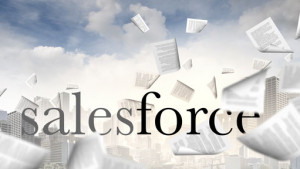- Erik Bullard
- Reading Time: 4 minutes

If your enterprise is not seeing your desired internal growth (or even if it is), it is still likely that your Salesforce relationship has grown over the years. Initially focused on Sales software that has blossomed into Service, Marketing, Financial Services, and eCommerce, Salesforce has positioned themselves as a viable potential partner for your enterprise, with offerings that could touch any number of areas of technology across just about any type of employee.
Salesforce has become a global leader in many areas and has experienced their own significant growth over the years. Their FY23 Q3 revenue was nearly $9B, representing 11% growth year-over-year, and they actually beat their previous guidance of $8.1B for this quarter. Now, this recent rosy picture is predicated not only on how Salesforce has been approaching the market for years (i.e., through a partnership and relationship driven approach), but also recent pressures that Salesforce has been facing to increase revenue and margins.
It is clear that Salesforce will continue to drive revenue numbers up by means of portfolio expansion, and it is critical for Salesforce customers to understand how these goals could impact their go-forward strategy. Here I will outline how Salesforce’s financials have impacted its goals and why these goals have led to a focus on Salesforce Enterprise Licensing Agreements.
How has Salesforce’s Financial Performance Impacted Its Goals?
Activist investors such as Elliott Management made large stakes in Salesforce last year, and, unsurprisingly, it resulted in a renewed focus on the dollars Salesforce is spending as well as increased the dollars they are bringing in. They were tasked with accelerating growth and increasing profitability.
Salesforce’s efforts included a recalibration of their executive team, as well as putting more pressure on organizations to adopt newer products, like Data Cloud and Einstein GPT, as well as Industry focused solutions that Salesforce has been pushing on the market, like Financial Services Cloud. They also recently imposed global price increases of ~9%. If you are renewing your deal after this global increase happened, be prepared to fight an uphill battle on your renewed software.
Salesforce has essentially been increasing the numbers that they are reporting for both revenue incurred and future revenue targets consistently each quarter and each year. There are a few exceptions, like when Salesforce actually lowered FY23 full-year revenue guidance by ~10% back in March of 2022, and depending on what Salesforce is focused on at a particular moment in time, there may be opportunity to strike while the iron is hot. We will pick apart some strategies and specific things to look for in later installments of this series.
What are Salesforce Enterprise Licensing Agreements and Why Will Salesforce Focus on SELAs in 2024?
One particular focus of Salesforce’s that we are seeing, particularly with enterprises that have larger and growing Salesforce footprints, is a focus on their Salesforce Enterprise Licensing Agreements (SELA), a type of Salesforce commercial construct. A SELA can differ from a traditional/standard software agreement in multiple different ways.
For example, a standard Salesforce agreement operates how you might expect from any typical SaaS provider – namely you are subscribing to a fixed set of products and volumes, with line-item prices, that add up to fees owed to the provider. Support and other services can add additional costs, but in general, a standard agreement with Salesforce is more straightforward.
SELAs, on the other hand, can have varied mechanisms for determining fees owed based on a set of product and volume entitlements. While there have been many changes to some of the contractual nuances/mechanisms over the years, Salesforce’s pitch has largely remained the same – they will tout a SELA as a more strategic construct, where you are not beholden to all of the line-item details. They will tell you how you actually get more access, more flexibility, and cite other benefits such as reduced management overhead with regard to license provisioning.
In practice, however, many of these “benefits” are not actually geared towards improving things for the customer. Often, SELAs will be one bundled price for all products in your portfolio, which naturally poses significant problems if you want to make any underlying changes to your portfolio downstream.
Wherever there is any ambiguity, expect Salesforce to capitalize. In fact, it is more likely that a SELA can open more pathways for Salesforce to increase your organization’s spend over the course of the term you signed, and beyond. We are seeing Salesforce be more aggressive with regard to pushing SELA constructs on to organizations, especially when they are growing or considering new capabilities.
The Bottom Line
As we continue to explore SELAs and the impact they will have on Salesforce customers, there are a host of issues that customers we have worked with are experiencing with their SELA constructs. Problems such as a lack of overall transparency, minimal flexibility, lost value from entitlements not being fully utilized or, in some cases, being utilized at all, and spiraling/unforeseen costs are simply all-too common.
At UpperEdge, we help clients understand their Salesforce proposals and negotiate the most competitive terms while maintaining a strategic relationship with Salesforce. For more on how we can help, explore our Salesforce Advisory Services.
Related Blogs
Don’t Let Divestitures Undermine Your Salesforce Negotiation
SaaS Price Increases: What If Vendors Only Charged More When You Got More?
Salesforce Increasing Pricing and Adding Agentforce Options: What Customers Need to Know Now
About the Author

